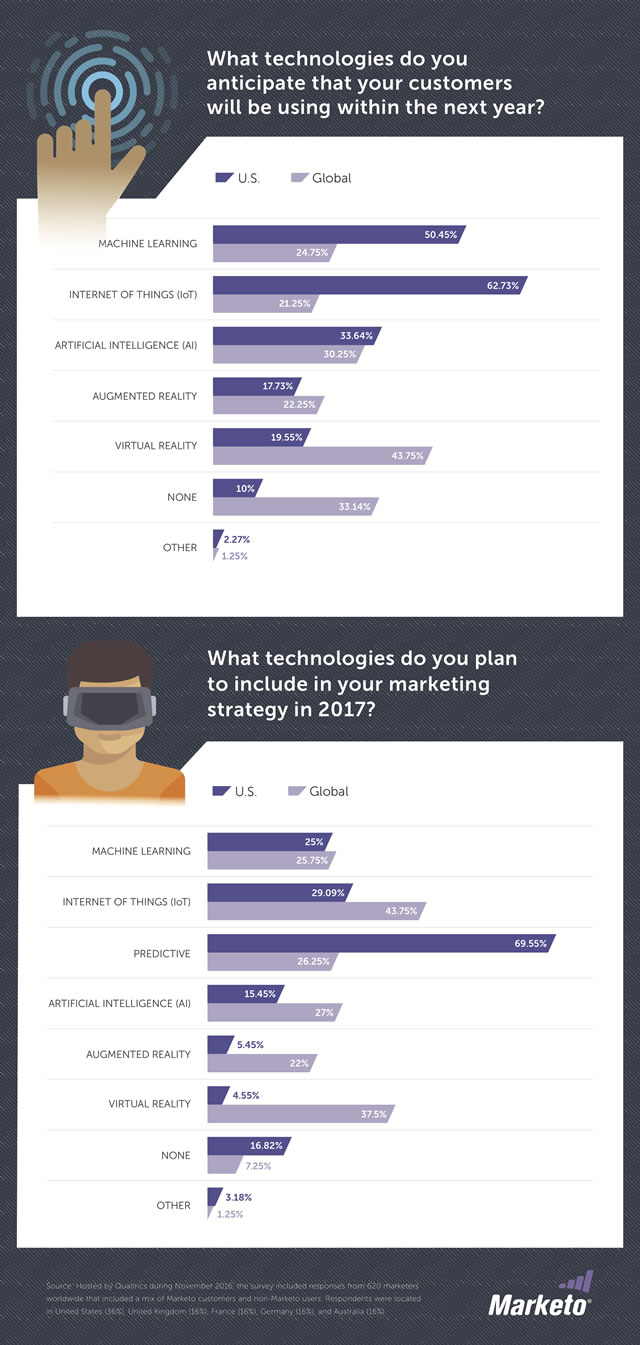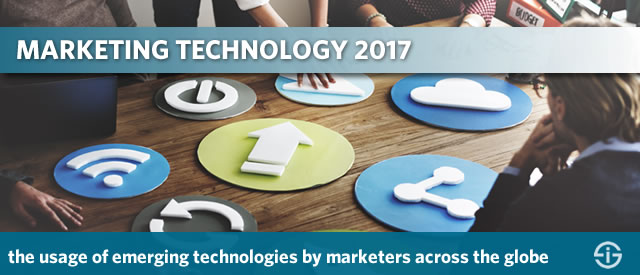The people at marketing automation software vendor Marketo conducted research to look at ‘newer’ technologies and what their effect will be for marketers.
As the infographic below indicates there are significant differences between the US and the rest of the world, both with regards to expected consumer adoption and the plans to include the different types of marketing technology in marketing strategies for 2017.
In the US, Marketo says, 57 percent of respondents believe that predictive analytics is poised to be the main marketing technology for customer engagement. In contrast, only 11 percent of international marketers believe the same.
US marketers go for predictive analytics, international marketers leverage IoT and VR
This reflects in the planned usage of predictive analytics in 2017 in marketing as the infographic shows (69.55 percent in the US versus 26.25 percent in other countries).
The other way around, the Internet of Things (IoT) is seen as the potentially primary channel for customer interaction by 31 percent of international marketers, while this is only the case for 16 percent of US marketers, Marketo states.
43.75 percent of international marketers plan to include IoT in their marketing strategy in 2017, in the US this is the case for 29.09 percent of respondents.
When we speak about the rest of the world or international marketers, we mean marketers from the UK, Australia, Germany and France. In other words: the survey only focused on a few countries, mainly European and the APAC region is only represented by Australia so Asian countries, the Middle East, Africa, South America, Eastern Europe, the Nordics and most Southern European countries aren’t represented.
Excitement on new marketing technology touchpoints is high but spend differs
Still, the discrepancies between US and international marketers seem pretty striking. The only thing they tend to agree on is an excitement regarding the many new touchpoints and interaction opportunities brought upon us by new marketing technology.
The perceptions regarding the usage of the Internet of Things for marketing and customer interaction (we wouldn’t call IoT a channel, yet the survey announcement doesn’t indicate what types of IoT use cases are deemed important by marketers, nor in what industries this is the case), are interesting as you’ll read below.
US marketers further seem to focus less on machine learning and on artificial intelligence than their international colleagues.
Another interesting difference exists between the expected usage by consumers of augmented reality and virtual reality and the planned usage of AR (augmented reality) and VR (virtual reality) by marketers.
Reporting and (predictive) analytics
It’s clear that in today’s data-intensive consumer and marketing reality, analytics are essential. Still, this doesn’t show enough yet.
The difference in perceptions regarding the usage of predictive analytics is striking, although regional attitudes can play a role too.
Overall, we quote from the press release, “37 percent of marketers feel better reporting and analytics to make sense of all the data would be the key to successfully maintaining customer relationships, while 33 percent say they require a platform to keep up with the speed and volume of interactions”. That seems like a relatively low percentage.
The Internet of Things for new touchpoints: understanding regional differences
While the optimism of international marketers regarding the usage of IoT might seem too optimistic, it is more or less in line with IDC’s findings on the IoT market in 2017 and beyond.
As IDC found, consumer IoT spend is relatively far more important in Western-Europe, where the majority of non-US Marketo survey respondents comes from. While consumer IoT being the fourth largest industry in 2016 globally, it is poised to rank second in Western-Europe in the period throughout 2020, overtaking transportation IoT spend and utilities IoT spend. This makes Western-Europe an exception.
Interesting: while the Marketo survey indicates that international marketers tend to focus more on IoT as a collection of new interaction and touchpoint opportunities than their US peers, the IAB IoT research, which was announced in December 2016, only looked at marketing and IoT in the US, exactly where marketers don’t seem to think IoT is a marketing technology priority for 2017 from an implementation viewpoint. Work for the IAB outside the US? Moreover, the IAB research only looked at consumer-owned IoT devices but the touchpoint opportunities go way beyond that.
A final note in this regard: the main consumer-related IoT use cases revolve around smart home automation (also think smart media and entertainment) and industry-specific applications such as telematics in insurance and cross-channel opportunities and digital signage in retail (and beyond)
So, the composition of the panel is important and it’s essential to know which kind of touchpoints we talk about when gauging marketer’s interests. We can’t repeat it enough: while predictive analytics, for instance, is a pretty well-described and well-known marketing technology, the Internet of Things is not a thing nor well-described or understood by many. Use cases are crucial here.
More in the press release and in the Marketo blog where you also find the infographic.

Top image: Shutterstock – Copyright: Rawpixel.com – All other images are the property of their respective mentioned owners.


